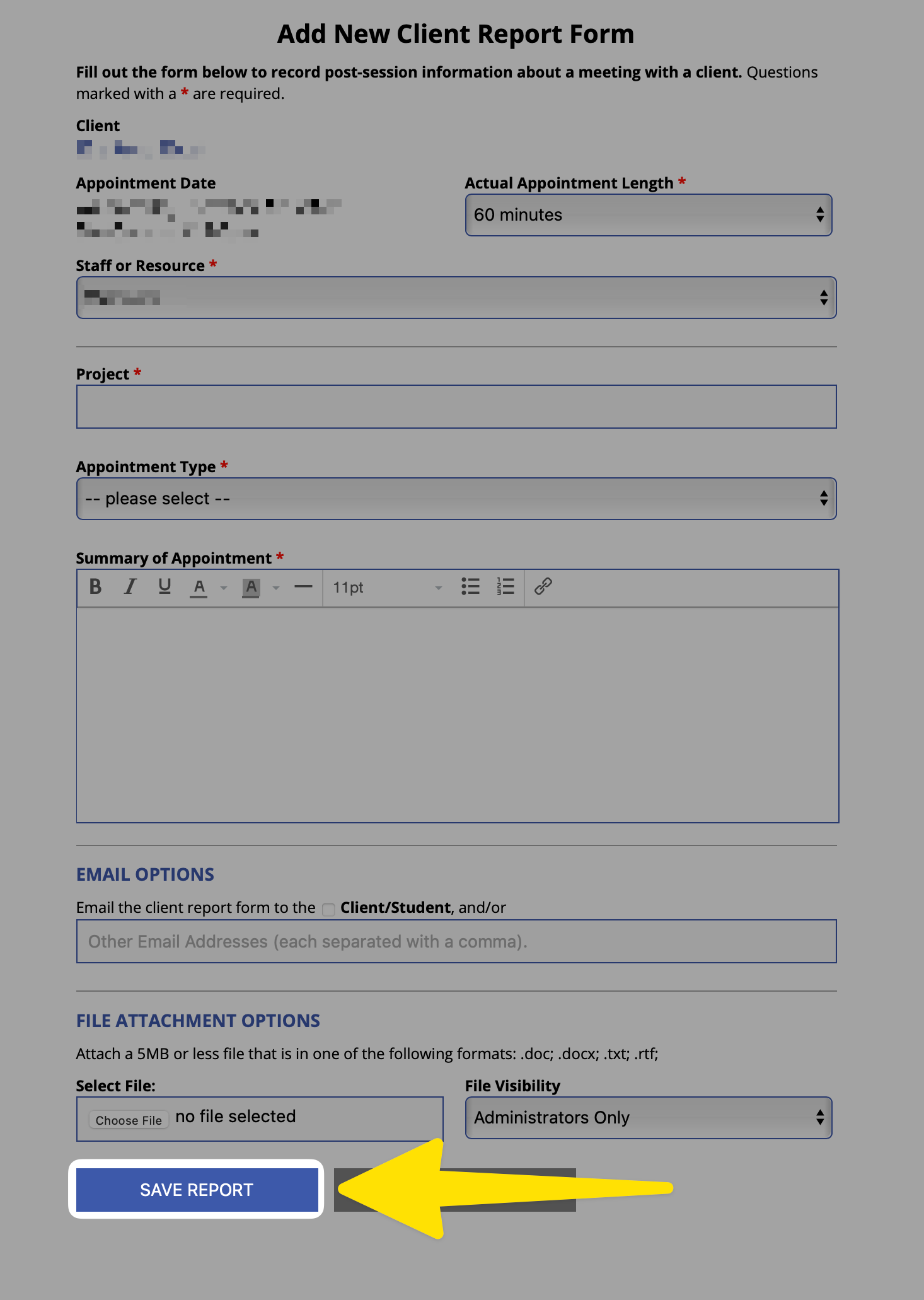Appointment letters are official documents sent electronically to writers after every appointment. They summarize the work you and the writer have done, and help writers remember key learning opportunities from the appointment. They also help the Writing Center keep careful records of our work with writers.
📝 Why Appointment Letters?
Appointment letters enact the Writing Center’s core belief that “writing facilitates creating and sharing knowledge.”
Letters give us the opportunity to reinforce learning with writers, and help us share that knowledge with others at the writer’s request.
Letters document your work, provide opportunities to reflect, and help to refine and improve our practices.
Letters make the work we do visible to different audiences:
- The writer
- Other peer writing tutors
- Outside readers (when the writer requests)
- Writing Center administrators
While letters have multiple audiences, the primary audience is the writer, because their desire to work with a peer writing tutor is the main exigence for the appointment and any record-keeping that results from that appointment.
Letters extend Vincentian personalism beyond the appointment, by allowing you to display “a sensitivity to and care for the needs of each other” (DePaul University Mission and Values). Through a personalized letter to the writer, you connect with them, reinforce the accomplishments of each appointment, and show them how much you value their writing and their inclusion of you in their writing process.
Sometimes administrators or tutors will look at letters as part of researching our practices, given that letters are the central way that we document our work at the Writing Center.
📧 How to Write & Send Letters
Write an appointment letter at the conclusion of each appointment.
For a face-to-face or an online realtime appointment, use the final 10 minutes of the appointment to complete your appointment letter (or final 5 minutes of a 30-minute appointment)
For a written feedback appointment, use the last 5 minutes of the appointment to paste the summary letter into the appointment letter
Review your appointment letter for content, clarity, thoroughness, accuracy, organization, tone, and polish. Feel free to ask another tutor to be a second set of eyes on your letter as well.
Face to Face and Online Realtime Appointment Letters
After reviewing your face-to-face or online realtime appointment letter, save the client report form. Then check the box to send to the writer and any requested instructor or other third parties.
Written Feedback Appointment Letters
Receptionists review written feedback letters before they are sent. Once you have read over your written feedback letter, copy and paste it into the client report form. Do not check the box for sending the letter. Save the client report form and upload the document to Google Drive. Inform the receptionist that your written feedback is ready.
If the receptionist requests any revisions to your letter, make sure to copy and paste the revised letter into the client report form—replacing your first letter draft.
Once the receptionist has reviewed the letter—and any revisions have been addressed—the receptionist will email the feedback to the writer and share the letter with any requested third parties.
📩 The Five Letter Components
Appointment letters are key to facilitating clear and transparent communication between tutors and writers. Here you will find the components that make up all appointment letters and how you are expected to integrate them into your own appointment letters.
Letter Component 1: Rapport
Developing strong rapport is crucial in our work with writers. To build rapport with writers, peer writing tutors listen, support, encourage, and communicate in appointments. In an appointment letter, you should cultivate rapport with the writer by personally addressing the writer with a greeting, thanking the writer for visiting, reflecting on the ways you enjoyed working with the writer, offering encouragement and support for their writing process, and/or inviting the writer to schedule again.
Open Your Letter with Rapport
Hi Erin! Thank you for visiting the writing center today and sharing your work with me! I felt like I learned a great deal about the nursing profession that I did not know before. As my sister is in the medical field, it felt really cool for me to get a glimpse into the world/education that she also received.
In this example, Maggie greets the writer by name, thanks the writer, and shares a personal connection with the writer’s work, all cultivating their rapport with the writer.
Close Your Letter with Rapport
Best wishes as you revise your paper to include more paraphrasing. If you have any further questions or would like more feedback, please feel free to make another appointment. Happy Writing, Maggie
By offering support for the next steps, the peer writing tutor further establishes a supportive rapport with the writer. By also inviting the writer to schedule another appointment, the peer writing tutor maintains the welcoming nature of the Writing Center.
Letter Component 2: Exigence
An exigence is an issue, problem, or situation that causes or prompts someone to write, speak, or act. In your appointment letter, describe the prompt, genre, or project along with the questions or requests that motivated the writer to schedule the appointment. By clearly stating the exigence, you demonstrate to the writer who reads your letter that you listened to their concerns and situation as expressed during the appointment and/or in the appointment form.
In the following example, a peer writing tutor explains the particular exigence motivating the structure and progression of the appointment.
You noted that you came to the Writing Center today to get a better understanding of the requirements for your L4 Writing Proficiency Exam. You brought in a copy of the exam's portfolio requirements and asked if I could help explain the different types of essays you are required to include. I read through the explanations of each (Portfolio Essay, Expository Essay, Persuasive Essay, and Narrative Essay) and then provided my own understanding of each genre, including several examples.
Here, the peer writing tutor is clear about the writer’s exigence—understanding the portfolio requirements. The strategies the peer writing tutor used during the appointment, including explaining types of essays and providing examples, help the writer respond to this exigence.
Letter Component 3: Agenda
The agenda describes 1, 2, or 3 points of focus. In a letter for an appointment, describe the agenda you set and revisited throughout the appointment with the writer. Whether you stay with the initial agenda or modify it as you go, make sure your letter reflects those decisions. In the following example, a peer writing tutor describes the writer and peer writing tutor's collaboratively set agenda.
You wanted help structuring your compare and contrast essay. I recommended we first identify the topics you want to write about and then figure out how to organize those specific topics.
This description of the agenda shows how the peer writing tutor collaboratively set an agenda by using the writer’s goal—to find a structure to their essay—and then recommending a second agenda item that provides the necessary scaffolding to accomplish the writer’s goal. By reading the agenda items in the appointment letter, the writer is reminded of the appointment goals and has the opportunity to confirm what learning happened in the appointment.
Letter Component 4: Methods
The methods section of a letter includes an account of the strategies or approaches you used to work with the writer to accomplish the agenda.
In a letter for an appointment, be specific about the work each person did during the appointment and the strategies you used to help the writer. Except when it’s accurate to use the pronoun we, avoid imprecise attribution of agency when describing the appointment. In most cases, sentences in letters should refer directly to the writer or to yourself as the subject.
In the following example, a peer writing tutor appropriately attributes agency to themselves and to the writer and includes specific strategies the two of them used during the appointment.
We read over your instructor's comments together and discussed what we thought was meant by them, so then you applied those ideas to the draft itself. Next, we looked at your portfolio annotation, and you read it aloud. I suggested how to make your annotations stronger by adding specific references to places within your portfolio text where you are meeting that goal.
By making the distinction between when they worked together (reviewing the instructor’s comments), when the writer was acting (reading aloud), and when the peer writing tutor was acting (suggesting ways to strengthen the annotations), this letter clearly details who did what during the appointment.
By including details about the strategies used in the appointment (reading aloud, making stronger connections), the letter serves as a reminder to the writer about transferable strategies they can employ in the future and potentially teaches an outside reader a new strategy.
Letter Component 5: Next Steps
Next steps are specific, actionable, realistic tasks that establish an agenda for the writer to consider as they continue to work after the appointment.
In synchronous appointments, next steps should be formulated with the writer, taking into consideration the collaboratively set agenda, and you remind the writer of the next steps they discussed during the appointment or offers suggestions of what the writer can do next.
In asynchronous appointments, make sure to suggest the next steps you think the writer should take, given the agenda you set to guide your feedback.
In the following example, a peer writing tutor describes tasks that establish an agenda for the writer’s future work.
As you continue with the next draft of your paper due at the end of this week, I encourage you to locate sources that describe the treatment of the upper class. You might consider asking a reference librarian for suggestions. I find working with a librarian often saves me time and gets me some of the best sources. Citing these sources in your paper may help you strengthen your argument by emphasizing the difference in treatment of the various socioeconomic classes of people living in New Orleans during Hurricane Katrina. After doing so, I recommended you read through the paper out loud a few times as to get a better sense of the overall clarity and organization of your draft.
This next steps section is specific in its description of how the writer can strengthen their argument by incorporating additional sources, actionable in its language (through words such as locate, asking, citing, and emphasizing), and realistic for the time frame the writer has (later that week).
📂 Sample Appointment Letters
Annotated Sample Letter: Face-to-Face Appointment
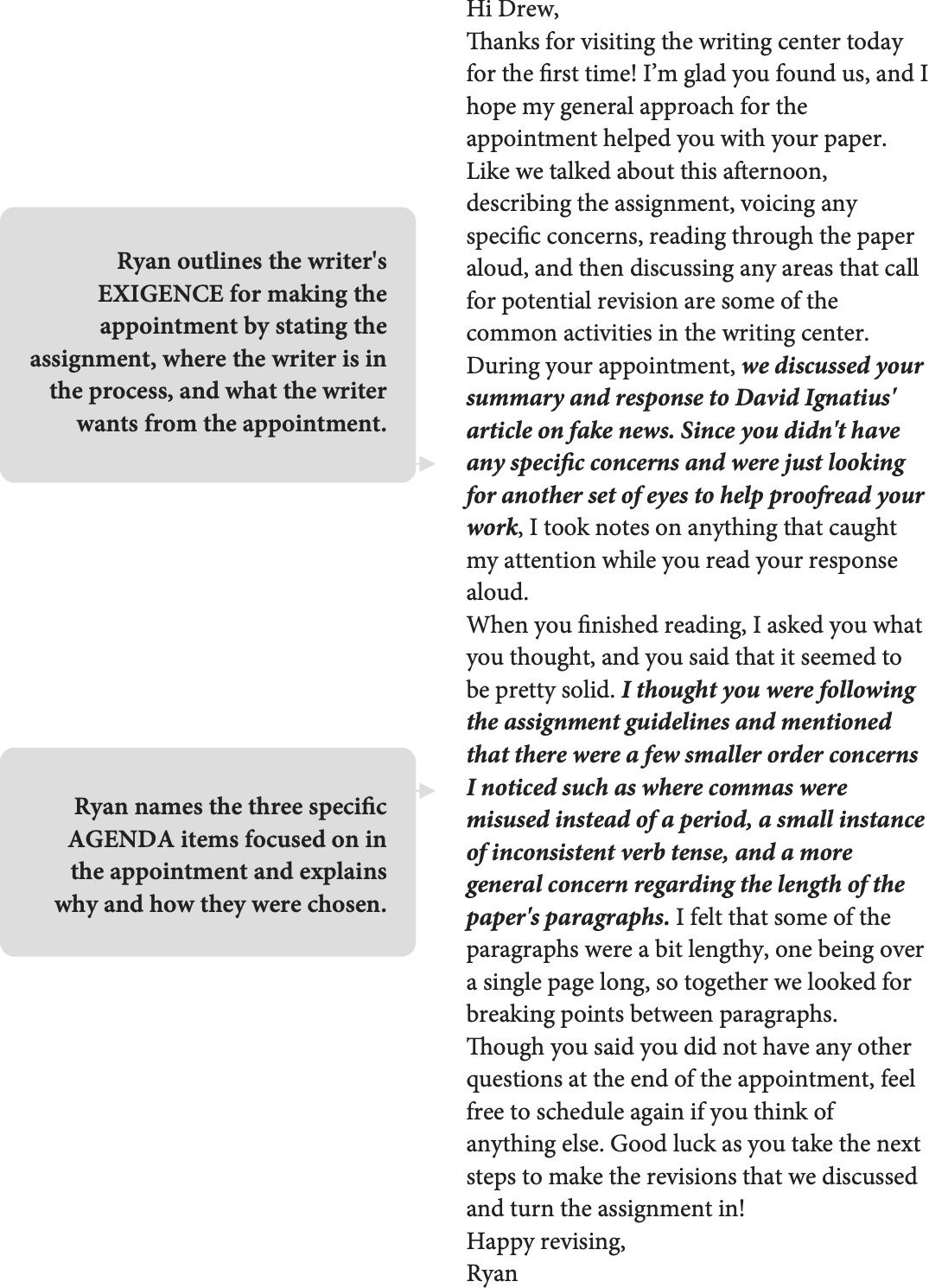
Annotated Sample Letter: Online Realtime Appointment

Annotated Sample Letter: Written Feedback Appointment
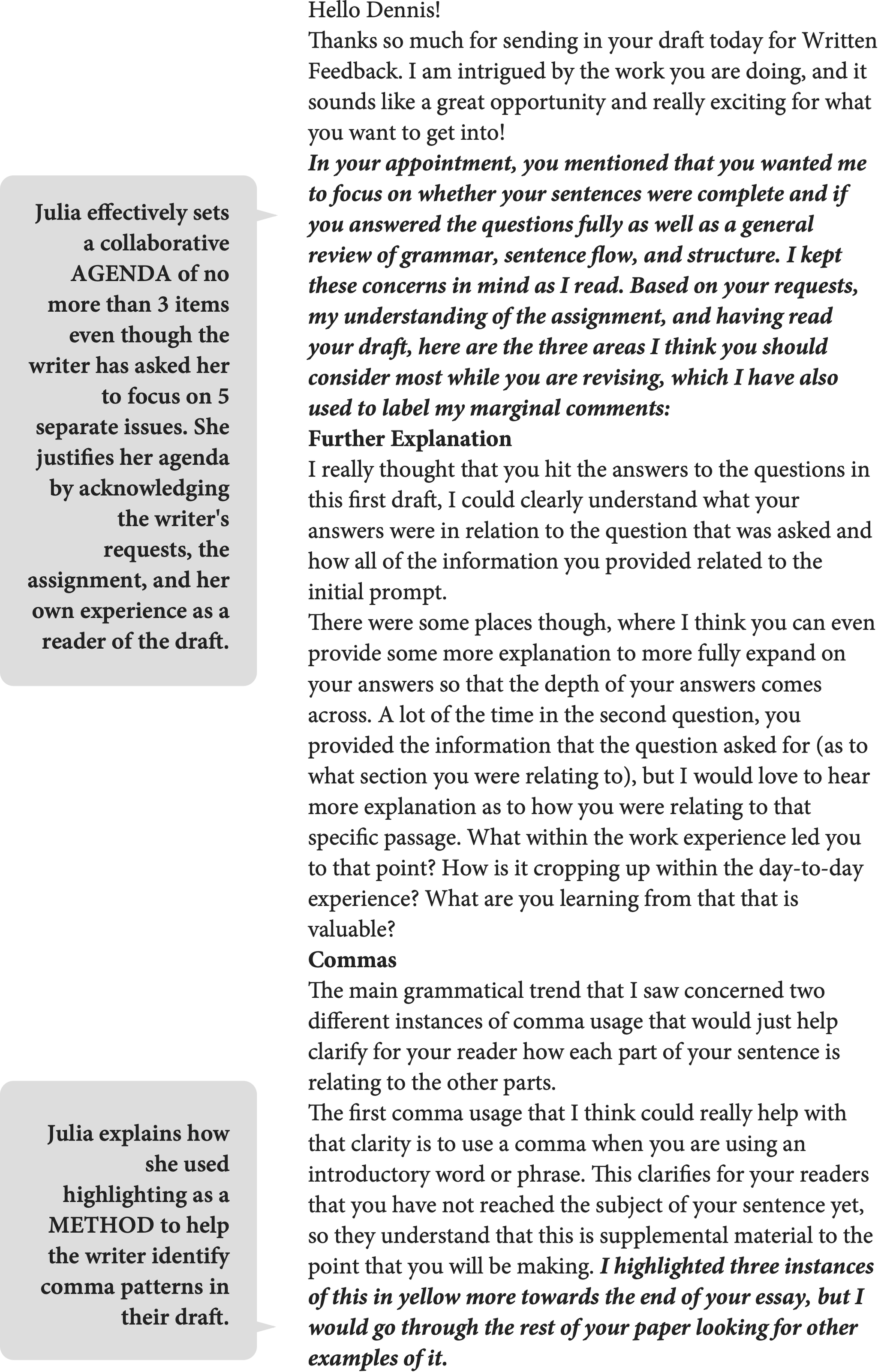
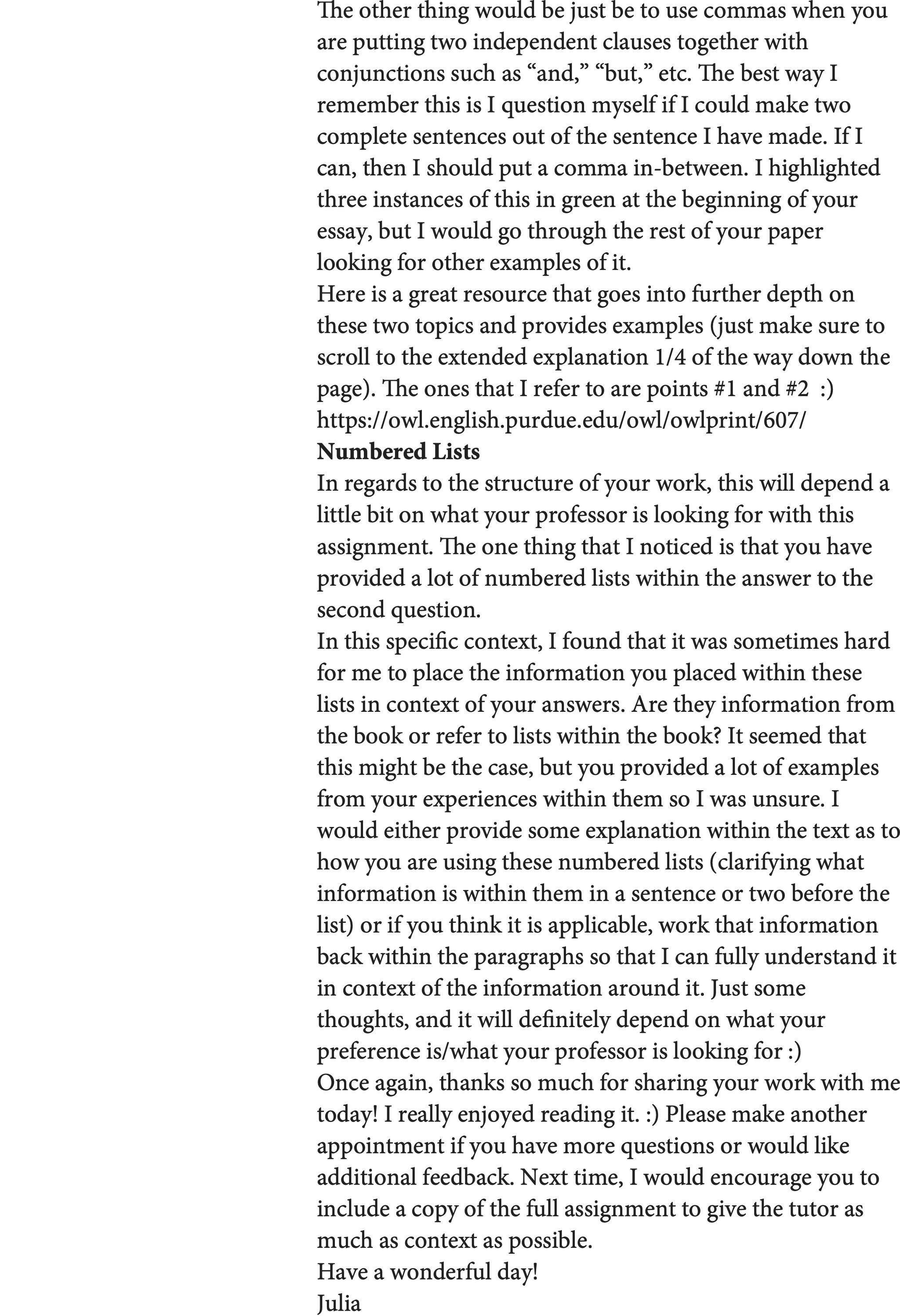
🧑🏽💻 Appointment Letters Audience
Understanding audience is a key component of any good genre study and appointment letters are no exception. This page highlights the audience and goals of our appointment letters to help tutors better understand the genre conventions and expectations.
How Writers Use the Letters You Write Them
Writers may use the information in an appointment letter to facilitate further drafting, revision, or editing—recalling, for example, what you discussed during an appointment or the methods you used to work through your agenda. For example, reminding a writer in the appointment letter how you created a reverse outline to address the organization of their draft might prompt the writer to try reverse outlining for the next section of their paper or for their next draft. Detailing for the writer the methods used in the appointment also helps “develop better writers along with better writing,” as writers have a written record of personalized feedback and methods to potentially transfer to new writing contexts.
Letters Help You, Other Tutors, & Writers
Many writers have multiple appointments throughout a quarter or academic year; appointment letters help you or other tutors scaffold each appointment for new learning based on prior agendas and methods (Nordlof, 2014). Peer writing tutors’ insights into prior agenda foci and the methods used with a particular writer help achieve the “continuity of instruction” that the National Writing Centers Association argued is 1 of the 6 “basic guidelines” for a peer tutoring center (Simpson, 1985, p. 38).
Letters Help Instructors & Others
The writer may request, or it may be a requirement of a writing fellows course, that the appointment letter also be shared with a third party, such as an instructor. A well-written letter not only favorably represents the Writing Center, but also, as Cogie (1998) argues, “supplies faculty with otherwise unavailable perspectives on their students and their own teaching” (p.49). Letters help shape the perspectives that DePaul instructors have about the Writing Center, their students, and the work of writing itself.
🤓 Writing Effective Letters
Letters serve as the main line of communication between writers and tutors. Here are some different styles that tutors can utilize to make sure their letters are effective in establishing and building communication and dialog with writers.
Write “Coaching Style” Letters
Bugdal, Reardon, and Dean (2016) conducted a study to gauge how different stakeholders—writers, tutors, and faculty—assessed the efficacy of five different styles of post-appointment session notes. They found that writers by and large preferred a “coaching” style note that used second person. Thus, a letter to the writer is a particularly effective genre for communicating with our primary audience.
Avoid Evaluative Language
Your letter is an opportunity to support the writer beyond the appointment, so write directly to the writer. Letters should be descriptive rather than evaluative. Evaluative language can undercut the trust you established with a writer, can place you in a position to contradict the final evaluator (i.e., instructor, employer, graduate school committee), and can create unfair bias for the next peer writing tutor who works with that writer.
Evaluative language makes a universal claim of the quality or success of something or someone. For example, phrasing such as “Your draft is strong”; “You are a great writer”; or “Because your thesis is solid, we decided to focus on transitions” may send the message that no further revision, change, or learning is needed. Instead, describe what happened as objectively as possible (e.g., “After reading the prompt, we decided to prioritize organization.”).
Additionally, refrain from evaluative language that disparages an assignment, course, or instructor in the letter (e.g., “This assignment was confusing” or “Your instructor doesn’t understand what passive voice is.”). While lending an empathetic ear to a writer can be important, you want to focus that understanding on how best to help the writer navigate a challenging situation.
Offer Process Praise
Avoiding evaluative language, however, doesn’t mean you should avoid giving praise. Process-based praise can be highly effective in motivating revision, risk-taking, and learning (Maclellan, 2005). Frame praise in terms of what behaviors and attitudes you want to encourage the writer to repeat or do more:
I liked how you included specific examples about your personal experiences because it helped me understand the importance of your topic to you.
I appreciated that you varied your sentence structures because it held my interest as a reader and helped show me what points you wanted to emphasize.
By including process-based praise in your appointment letter, you maintain focus on formative feedback while also providing encouragement to the writer.
👧🏽 Orphan Appointments
A big part of your job is making sure you complete appointment letters in a timely fashion—ideally at the end of each appointment or by the end of each shift, before you leave or sign off.
In rare cases where you need to check if you have failed to complete your letters, i.e., have not completed a “Client Report Form” in WCOnline, you can search for the appointments you’ve had that are missing letters by using a feature in WCOnline called “Orphan Reports.”
How to Check for and Identify Orphan Reports in WCOnline
- Hover cursor over/Select the “Welcome, YourName ▼” menu

- Select Report: Master Listings
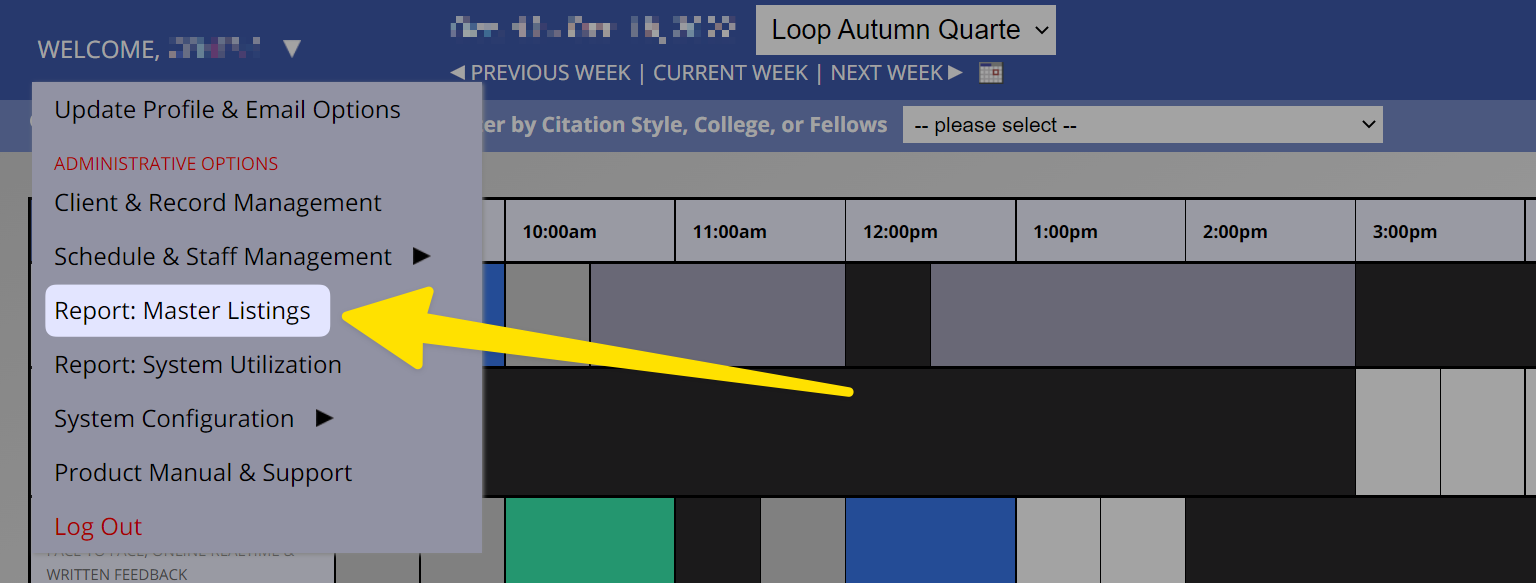
- On the Master Listings Report page
- Change the Starting Date Limit to the first day of the quarter and the Ending Date Limit to today
- Change Content Limit from default selection Active Appointments to “Orphan Appointments Only”
- Change Staff or Resource Limit field to your name; IF you work remote shifts, you will need to complete this process twice, searching for both YOUR NAME and YOUR NAME (Remote)

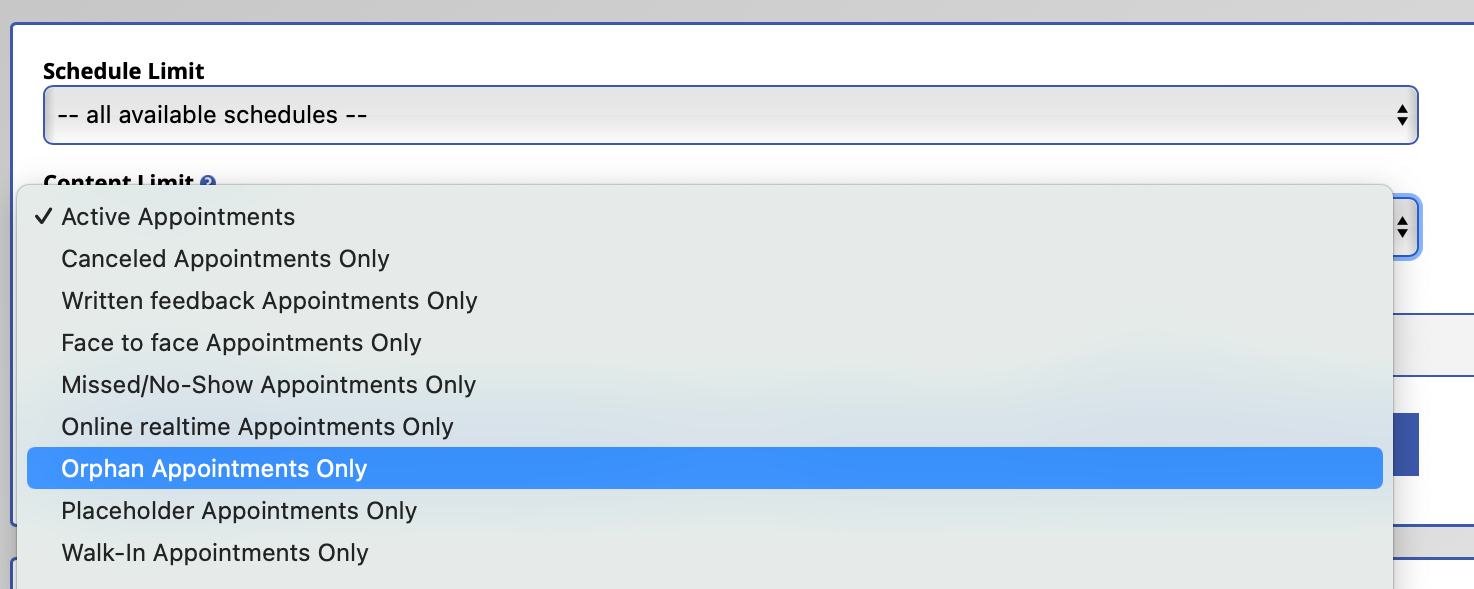
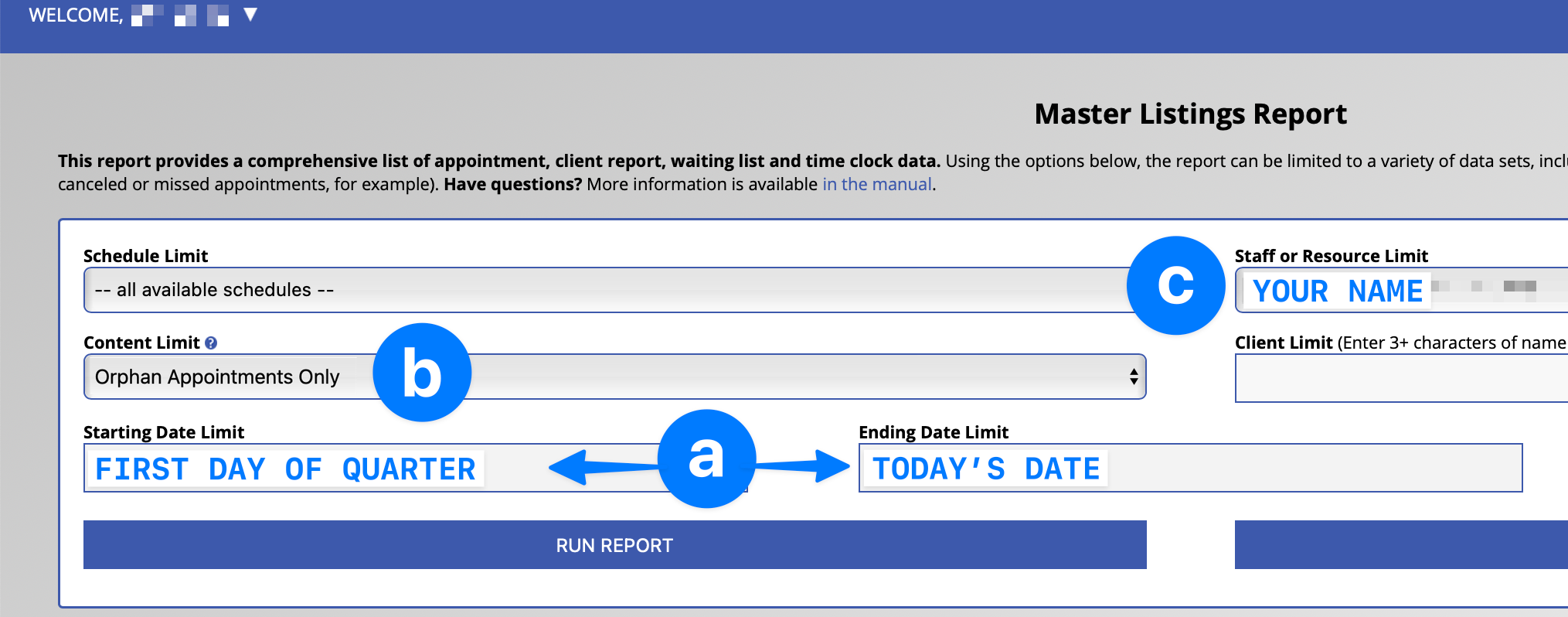
- Any Orphan Appointments—those without a Client Report Form—will be listed by Date

How to Fix Orphan Reports
For any appointments you need have not completed a Client Report Form for you need to do so ASAP so that writers have a comprehensive record of what each of their appointments focused on and accomplished.
- Select View Appointment

- On the Existing Appointment window that pops up, select “Add New” under the Post-Session Client Report Forms header

- Write up appointment letter or copy summary letter from Written Feedback document you’ve accessed from Google Drive > Writing Center > Written Feedback > Current Quarter Archive folder and Save Report
